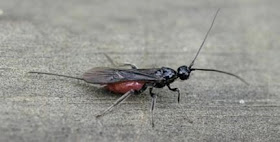This spring I had posted some fun plants I had found in my wooded area, mentioning I would not go into the little ravine to retrieve them because of the poison ivy. It was suggested I do a posting about poison ivy, Toxicodendron radicans.
Leaves of three, let it be....
We have a good deal of poison ivy in our woods. The little saying above makes it clear...three leaves. The leaves are irregularly toothed. The leaves can be very small or very large. Next to the poison ivy is Virginia Creeper, Parthenocissus quinquefolia, a five leafed vine. When Virginia Creeper is small, sometimes only three leaves are present....easy to confuse the two.

The leaves are glossy on top and lighter color on the underside. It is a woody stemmed vine. When it climbs up a tree the vine stem has hairy roots all along the stem-- easy to identify. It can take the shape of a shrub or climb a tree or be a ground cover. It is a tricky plant.
The photo below was taken by a former neighbor from Seaford. She found a great specimen in flower. You can see the woody stem and the shiny leaves.
I am including a number of photos of poison ivy because the leaves are so irregularly toothed, one might think it is a different plant. This follow photo, while a bit fuzzy, shows how large the leaves can be. Next to it are the leaves of a Sweetgum, Liquidambar styraciflua.
Notice how little the toothed ridges are on the one below.
In many of the pictures you can see a bit of red. In the fall the poison ivy turns brilliantly red. It is quite pretty.
Poison ivy is of concern to those of us in the gardening world because it contains the toxic oil called urushiol. For many of us it causes blistering rashes. The oil can remain for a long time on the skin as well as our clothes and shoes! Urushiol can be found in other plants in the Cashew family,
Anacardiaceae, of which poison ivy is a member. I am sure you know of a few others....poison sumac and poison oak. Listed below are a few great web links for all three. Poison oak is very similar in appearance to poison ivy, but it has a velvety pubescence on the stems.
These three plants are not the only toxic urushiol laden plants. Cotinus, smoke trees are included in the family. Cashews of course and pistachios are also in this family. Roasting the nuts makes the nuts edible, no problem.

But, here is the twist.....
Mangoes are also in this family. The urushiol is in the peel and into the flesh about 5mm deep. How did I come across this information??
Check out these lips..... they look like they are collagen filled movie star lips, until you see all the water blisters.
This is as wide as she could smile........
We did a Google search for allergies...thinking she might be allergic to a new lip balm or to her own saliva. Finally the search led us to this posting...
Food that destroyed my face--- where the blogger said she had eaten a mango. What??!!? Yes, darling daughter had eaten a couple mangoes in the last few days-- the last one she ate over the sink, eating it out of the peel. BINGO! Then we found this website--
Food for Thought more information about mangoes. Who knew? And yes, she is severely allergic to poison ivy.
Well, a trip to the urgent care clinic to get some prednisone and more antihistamines made for a great start to her visit to South Carolina!
So, as you go out into the garden be on the lookout for poison ivy. And when you are in the market, keep your eyes open for those scary mangoes!
©Copyright 2011
Janet. All rights reserved. Content created by Janet for
The Queen of Seaford.
 words and photos by Janet,The Queen of Seaford.
words and photos by Janet,The Queen of Seaford.



























